Form 1040: Guide for Florida Small Business Owners
Tax season doesn’t come with confetti and balloons, it usually comes with coffee-fueled nights, scattered receipts, and more than a little stress. But for all the forms floating around, there’s one that really matters: Form 1040. Whether you’re a small café owner in Tampa, a roofing contractor in Orlando, or a freelance designer working from a Miami co-working space, Form 1040 is where your financial year gets summed up and sent off to the IRS.
And here’s the truth: once you understand Form 1040, the rest of tax season feels far less intimidating.

Form 1040 Explained Simply
At its core, Form 1040 is your yearly conversation with the IRS. It’s the place where you report how much money you made, subtract what you can legally deduct, and see whether you owe more taxes, or get a refund. Think of it like a scoreboard. Income on one side, deductions and credits on the other. When the dust settles, the bottom line tells you who owes whom.
The beauty (and pain) of Form 1040 is its universality. Almost every taxpayer files it. It’s the foundation of the federal tax system. Yes, there are variations, but whether you’re a retiree living in Naples or a college student picking up shifts at a Daytona Beach bar, your tax story funnels into this document.
What is a 1040 Form?
Let’s keep it clear and official. A 1040 form is the U.S. Individual Income Tax Return. It’s published by the IRS and designed to capture your entire financial year in one place.
Wages? Check. Business profits? Yep. Dividends, rental income, retirement distributions? All here.
When people ask “What is a 1040 form?” the simplest answer is: it’s the IRS’s master form to figure out your tax bill. Everything else, your W-2s, your 1099s, your business records, is just supporting evidence. The 1040 pulls it together.
For the official word, here’s the IRS resource straight from the source: IRS Form 1040 page.
What is a 1040 Form Used For?
Now let’s tackle the other common question: “What is a 1040 form used for?”
It’s used to:
- Report your total income (from all sources).
- Claim deductions (mortgage interest, medical expenses, small business costs).
- Apply credits (Child Tax Credit, Education Credit, Earned Income Credit).
- Calculate your final tax owed or refund due.
Here’s a Florida-flavored example. Suppose you’re a roofing contractor in Orlando. You made $120,000 in revenue this year, but you also spent $40,000 on supplies, subcontractors, and equipment. Through Schedule C, those expenses reduce your taxable income. But your story doesn’t end there. Maybe you also paid health insurance premiums, contributed to a retirement plan, or qualified for a small business credit. All of that ties back to your Form 1040.
Without this form, your tax picture is incomplete.
Versions of Form 1040
Not all taxpayers are the same, and the IRS knows that. That’s why there are variations:
- Form 1040: the standard version, used by most taxpayers.
- Form 1040-SR: designed for people aged 65 and older, with larger text and simplified instructions.
- Form 1040-NR: for nonresident aliens with U.S. income.
A quick note: older versions like the 1040EZ and 1040A have been discontinued. The IRS decided one form (with add-ons like schedules) works better.

Why Form 1040 Matters for Florida Small Businesses
Florida might not have a state income tax, but federal taxes still apply. For small business owners here, Form 1040 is the gateway.
- Sole proprietors report their business income and expenses via Schedule C, which connects back to Form 1040.
- LLCs (that are single-member) often file as pass-throughs, meaning their profits and losses flow directly onto Form 1040.
- Independent contractors (think Uber drivers, landscapers, Airbnb hosts) all use Form 1040 to capture earnings.
This is why understanding the form isn’t optional, it’s survival. And if you’re looking for simple, affordable bookkeeping support that connects directly with your Form 1040 filing, check out our Bookkeeping Lite service. It’s built with small business owners in mind, keeping your numbers clean so tax season isn’t a nightmare.
Curious about other industries we support? Check out: Industries We Serve.
The Anatomy of Form 1040
Let’s roll up our sleeves and peek inside the form. It’s not as scary as it looks.
- Personal Information – Your name, filing status, dependents. (Yes, the basics matter.)
- Income Section – Wages, self-employment, dividends, retirement payouts.
- Adjusted Gross Income (AGI) – This is where adjustments like student loan interest or IRA contributions lower your income.
- Deductions – Standard vs itemized. For many small business owners, itemizing is crucial.
- Tax and Credits – This is where credits (like education credits) slash your tax bill.
- Other Taxes – Self-employment tax often surprises new entrepreneurs.
- Payments – Already paid through withholding or estimated taxes? List them here.
- Refund or Amount You Owe – The bottom line. The part that makes your heart race.
When you step back, the 1040 is like a flowchart. Income in, deductions applied, tax calculated, balance resolved.
Common Mistakes People Make on Form 1040
Even seasoned business owners slip up. Some of the biggest errors?
- Forgetting to report 1099 income. (Yes, the IRS gets a copy too.)
- Missing out on credits you actually qualify for.
- Miscalculating deductions.
- Not signing or e-filing correctly.
I once worked with a small contractor in Jacksonville who thought his accountant had “handled everything.” Turns out he left off $12,000 in 1099 income from side gigs. It wasn’t malicious, it was just sloppy. The IRS caught it, penalties piled up, and suddenly that refund he was banking on turned into a bill.
Moral of the story? Don’t cut corners.
Deadlines and Extensions
For most people, the tax filing deadline is April 15. If that date falls on a weekend or holiday, the deadline moves to the next business day.
But what if you can’t file in time? That’s where Form 4868 comes in, it gives you an automatic extension to file. Important caveat: it doesn’t extend the time to pay. If you owe taxes, interest and penalties still apply if you don’t pay by April 15.
This catches many small business owners off guard. They assume an extension equals more time for everything. Not true.

Smart Tips for Florida Small Business Owners
- Track year-round: Don’t wait until March to gather receipts.
- Separate accounts: Keep business and personal finances apart.
- Save for taxes: Set aside 25–30% of income for tax time.
- Work with a pro: Software helps, but nothing beats an expert who knows your industry.
If you’re ready to stop stressing about taxes, grab our Bookkeeping Lite Bundle today. It’s built for small business owners who want simple, affordable, tax-ready books without the headache.
Wrapping It Up
At first glance, Form 1040 looks intimidating. Rows of numbers, jargon, and references to schedules you’ve never heard of. But once you break it down, it’s just your financial story told line by line.
For Florida small business owners, mastering this form isn’t optional, it’s essential. Get it wrong, and you risk penalties. Get it right, and you keep more of your hard-earned money where it belongs: in your business.
FAQs Around Form 1040
Q: What is a 1040 Form?
A: It’s the U.S. Individual Income Tax Return, used by almost every taxpayer to report income and calculate taxes.
Q: What is a 1040 Form used for?
A: Reporting income, claiming deductions and credits, and figuring out what you owe or get back.
Q: Do I have to file if I made under $12,950?
A: It depends, filing thresholds vary by age, status, and type of income. Always check IRS rules.
Q: Is Form 1040 complicated?
A: It can be. But with clear records (and a little help), it becomes manageable.

